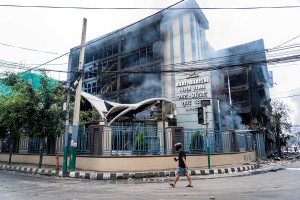Money
Shailung’s potatoes power rural economy, but name lost in transit
As harvest season begins in Dolakha, farmers celebrate a rich yield but resent their crop being sold as potatoes from Mude.
Kedar Shivakoti
Kumari Tamang of Chisapani in ward 6 of Shailung Rural Municipality, smiles brightly as she prepares to sell potatoes dug from her field nearly six months after planting.
The potatoes she planted in winter are now ready for market, and she is busy digging her fields.
In the high hills and Himalayan regions of the district, the rush to harvest winter potatoes has begun.
Potatoes are the primary source of income for residents living in the highlands of the nine local units in the district. Most of the district’s potatoes are exported from Shailung.
This year’s favourable weather has led to a good harvest, and Kumari is visibly pleased.
She expressed her happiness, saying the yield this year seems higher than before. “I estimate a better harvest this year,” she said. “Potatoes are our main source of income, and they must cover the entire year’s expenses.”
She expects to sell potatoes worth Rs400,000 to Rs500,000 this year.
“The price has not been fixed yet. The traders will come and decide,” she said. “We got a decent price last year. Let’s see what happens this time.”
However, she has one major complaint. It upsets her that the potatoes from Shailung are sold under the name “Mudeko Alu” (potatoes from Mude, a well-known potato-growing area in neighbouring Sindhupalchok district) in the market. “We rely on this crop to provide for our families, and it hurts when our produce is sold as something else. We always ask them to label it as Shailung potatoes, but once it reaches the market, they just call it Mudeko Alu,” she said.
Potatoes are cultivated on over 3,300 hectares in the upper regions of the nine local units of Dolakha district.
According to data from the Agriculture Knowledge Centre, the highest cultivation—about 1,400 hectares—is in Shailung Rural Municipality alone. Last year, Shailung supplied potatoes worth around Rs300 million, including seeds, to the market.
After the potato harvest, farmers in Shailung begin planting cauliflower and cabbage.
Bhakta Bahadur Magar of Sarangthali in ward 8 of the rural municipality, said the favourable weather has boosted production. “This year’s crop is better than last year’s,” he said. “The potatoes are well-formed, but prices are yet to be determined by the traders.”
He recalled getting up to Rs 50 per kilogram directly from the field last year.
Like Kumari, he too feels disheartened when Shailung’s potatoes are sold as “Mudeko.” “Shouldn’t our produce carry the name of our place?” he asked. “The potatoes are grown in Shailung, but someone else’s name gets the credit. Who will give identity to our crop? This issue should be raised.”
Shailung has developed as a pocket area for potato farming. Farmers here start harvesting potatoes they planted in the winter months of December–February.
In past years, poor roads often caused farmers to lose money because vehicles were delayed or obstructed, slowing the supply from reaching markets.
Now, with year-round blacktopped and gravel roads in place, farmers say those losses and risks have been significantly reduced.
“For years, we faced losses due to poor roads and didn’t get good prices. But that tension is gone—vehicles can now reach our fields directly,” said one farmer. He is preparing to send around Rs300,000 worth of potatoes to market this year.
In Shailung’s upper belt, most farmers depend on potatoes for household expenses, festivals, and children’s education.
A modest farmer can earn up to Rs50,000, while those with larger fields make as much as Rs1.2 million from potatoes.
Chhetra Bahadur Shrestha from Chisapani, in ward 6 of Shailung, said he no longer sells to traders.
Instead, he plans to go to the market, negotiate prices, and handle transport himself.
“In the past, contractors didn’t give us good prices because the roads were bad,” he said. “Now that the roads are improved, I’ll take my produce myself.”
He also said he wants to promote Shailung’s potatoes by selling them directly with the correct label.
Like Kumari and Bhakta, he’s dismayed that Shailung’s potatoes are misbranded.
“I will now make sure our produce is sold as Shailung potatoes,” he said. “Isn’t it unfair that our hard work benefits someone else?
“Farmers now need to take the lead in building the identity of Shailung’s potatoes—we may even need to start a campaign.”
He said this year the growing conditions were ideal, and the potatoes are looking well-formed.
Last year, he sold around Rs500,000 worth of potatoes. “Maybe this year I’ll reach Rs600,000,” Shrestha said. “They’re still underground, but the field looks promising—we’ll know for sure once they’re dug out.”
According to the Agriculture Knowledge Centre, last year alone, fresh and seed potatoes worth Rs700 million were supplied from the highlands of the district’s nine local units.
In the upper parts of Shailung Rural Municipality in Dolakha, potato fields planted in winter are now ready for harvest, and the digging rush has begun. About 1,400 hectares in Shailung are under potato cultivation.




 12.12°C Kathmandu
12.12°C Kathmandu













%20(1).jpg&w=300&height=200)
